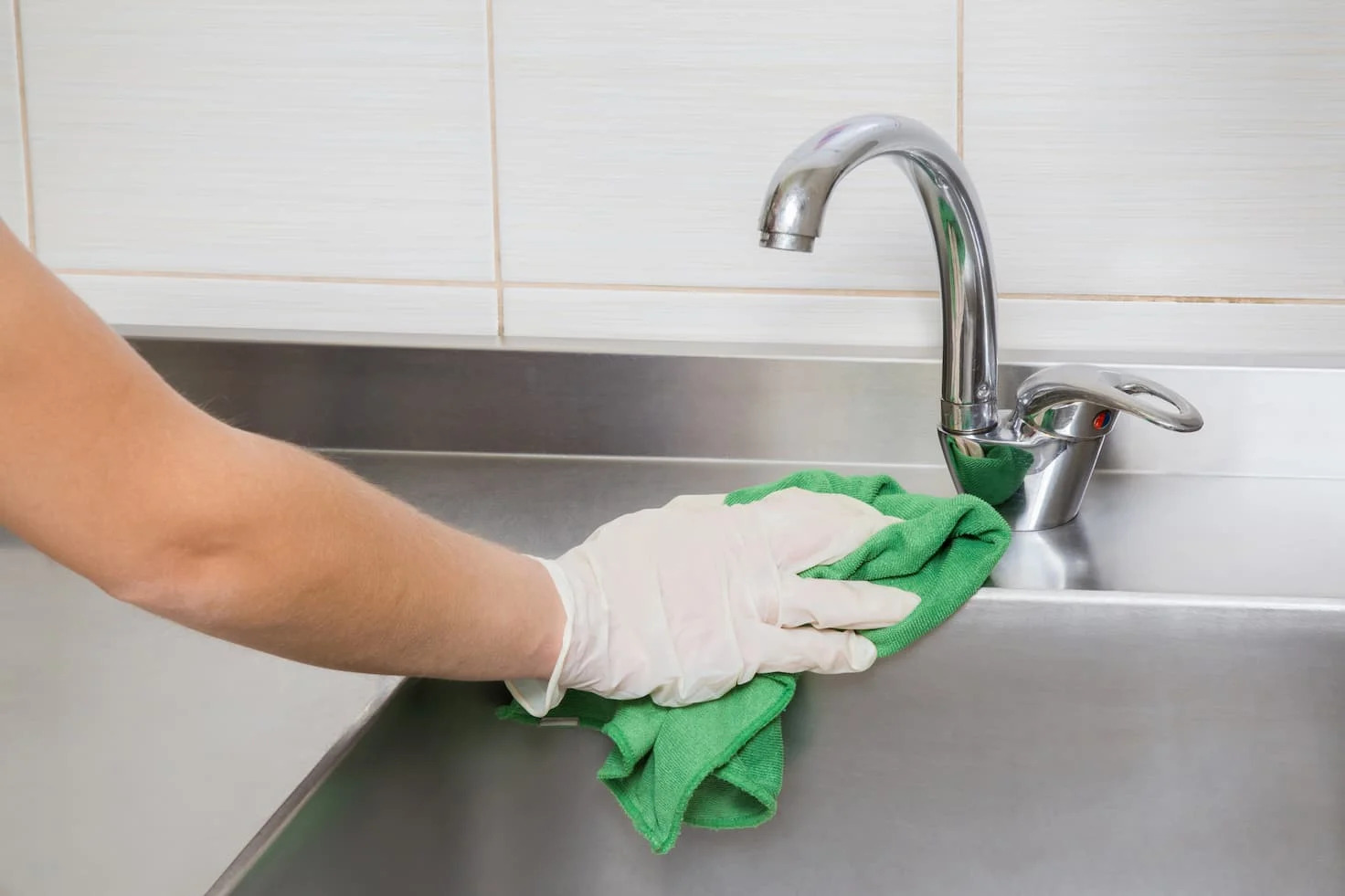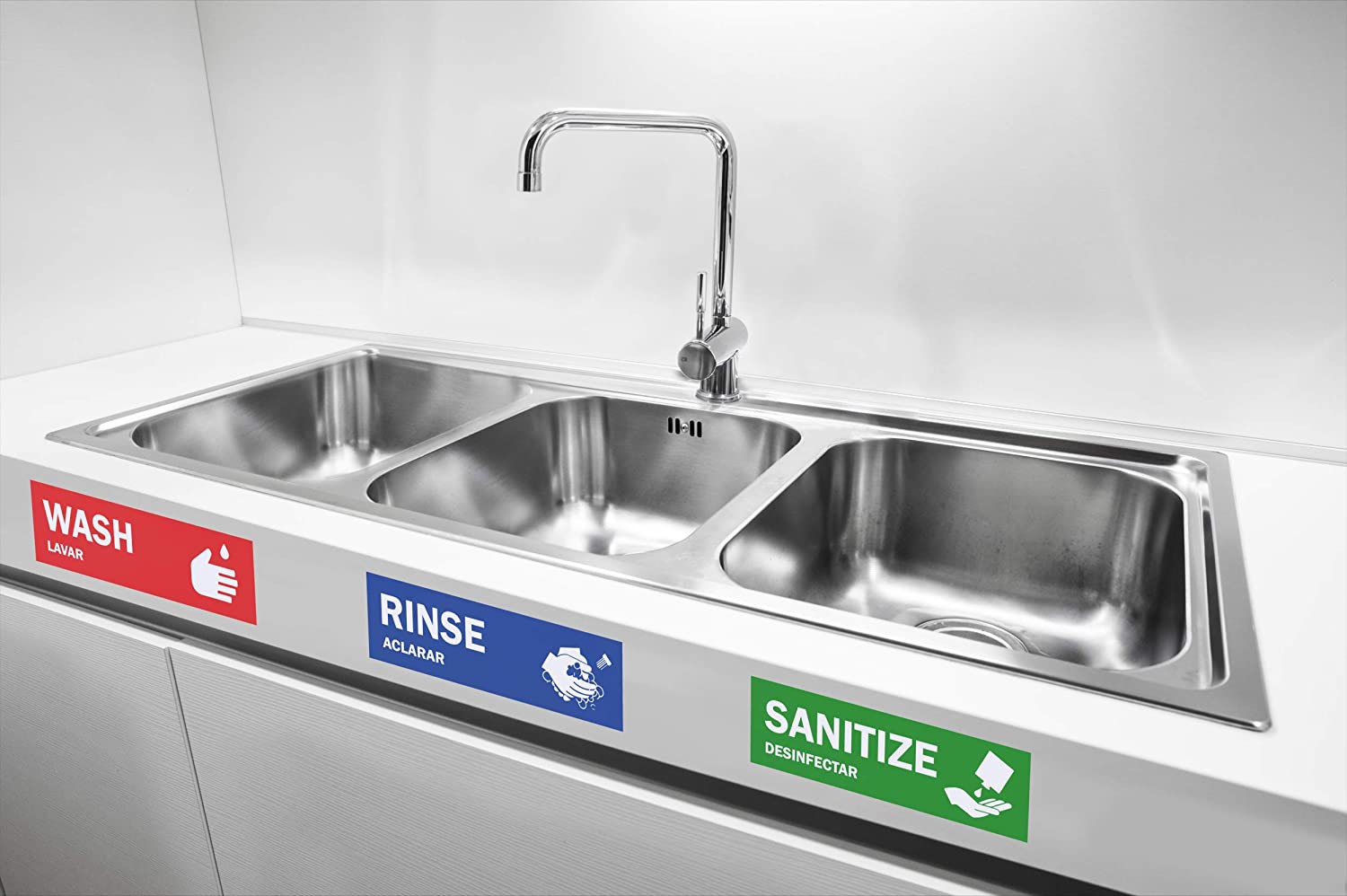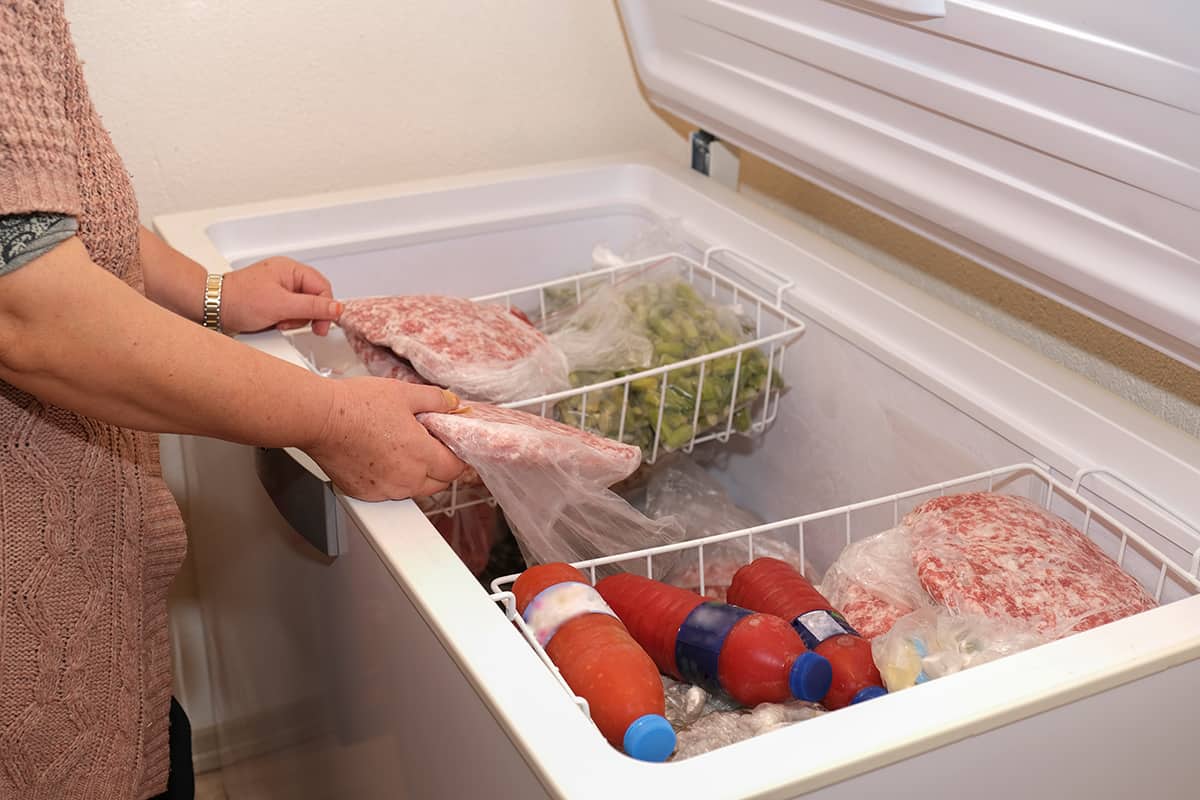Home>Articles>What Temperature Should Water Be In A 3 Compartment Sink


Articles
What Temperature Should Water Be In A 3 Compartment Sink
Modified: February 24, 2024
Discover the optimal water temperature for a 3 compartment sink in this informative article. Maintain cleanliness and prevent cross-contamination.
(Many of the links in this article redirect to a specific reviewed product. Your purchase of these products through affiliate links helps to generate commission for Storables.com, at no extra cost. Learn more)
Introduction
Welcome to the world of professional kitchens, where cleanliness and hygiene play a crucial role in ensuring the safety of both the staff and the customers. One of the essential components of maintaining cleanliness in a restaurant is a three-compartment sink. This sink is designed to facilitate the proper washing, rinsing, and sanitizing of kitchen utensils, such as dishes, glasses, and silverware.
While the three-compartment sink is a standard fixture in commercial kitchens, many people may not realize the importance of water temperature in this process. The temperature of the water used in each compartment can significantly impact the effectiveness of the cleaning and sanitization process, as well as the overall hygiene of the kitchen.
In this article, we will explore the significance of water temperature in a three-compartment sink and discuss the factors that influence the selection of the appropriate temperature. We will also provide recommendations on the ideal water temperature to ensure optimal cleaning and sanitization. Lastly, we will touch upon the consequences of using incorrect water temperature and share some valuable tips for maintaining the desired temperature consistently.
So, if you are ready to dive into the world of water temperatures and discover how they can make a difference in a three-compartment sink, let’s begin!
Key Takeaways:
- Proper water temperature is crucial for effective cleaning and sanitization in a three-compartment sink, impacting grease removal, sanitization, and cross-contamination prevention.
- Maintaining optimal water temperature requires regular checks, staff training, and adherence to regulations, ensuring a safe and hygienic kitchen environment.
Purpose of a 3 Compartment Sink
In a commercial kitchen, the three-compartment sink serves as a designated area for washing, rinsing, and sanitizing kitchen utensils, including dishes, glasses, and silverware. It is a crucial component of maintaining cleanliness and hygiene standards in food preparation areas. The purpose of a three-compartment sink is multi-fold:
- Cleaning: The first compartment of the sink is used for washing the utensils, removing any food debris, grease, or other contaminants. This initial cleaning step ensures that the items are ready for further processing.
- Rinsing: The second compartment is dedicated to rinsing the utensils after they have been washed. This step helps to remove any remaining soap or detergent residue, leaving the dishes clean and ready for the final sanitizing step.
- Sanitizing: The third compartment is filled with a sanitizing solution, typically a mixture of water and sanitizer, such as chlorine or quaternary ammonia. This step kills any remaining bacteria or germs on the utensils, ensuring that they are safe and hygienic for use.
The purpose of segregating these three functions into separate compartments is to prevent cross-contamination and maintain proper hygiene throughout the process. By keeping the washing, rinsing, and sanitizing steps distinct, the risk of transferring bacteria or contaminants from one utensil to another is minimized.
Furthermore, the three-compartment sink allows for efficient workflow in the kitchen. It ensures that dishes go through the necessary cleaning stages before being reused, reducing the risk of foodborne illnesses and maintaining the overall cleanliness of the establishment.
Overall, the purpose of a three-compartment sink is to provide a dedicated area for thorough cleaning, rinsing, and sanitizing of kitchen utensils, promoting food safety and hygiene in the commercial kitchen environment.
Importance of Water Temperature
Water temperature plays a crucial role in the effectiveness of the cleaning and sanitization process in a three-compartment sink. The temperature of the water used can impact several factors:
- Removal of Grease and Food Debris: Hot water is more effective in breaking down grease and removing stubborn food debris from kitchen utensils. It helps to dissolve fats and oils, making it easier to scrub away residue. High water temperature aids in the removal of tough stains and ensures that dishes are thoroughly cleaned.
- Sanitization of Utensils: Proper water temperature is essential for effective sanitization. The heat from hot water helps to kill microorganisms, including bacteria and viruses, present on the utensils. The hot water temperature accelerates the sanitizing process and ensures that the utensils are safe to use.
- Prevention of Cross-Contamination: Water at the appropriate temperature helps prevent cross-contamination by ensuring that any harmful bacteria or germs present on the utensils are effectively destroyed. By using the correct water temperature, you can reduce the risk of spreading bacteria from one utensil to another, maintaining a safe and hygienic environment in the kitchen.
- Efficiency and Time-Saving: Using water at the right temperature can significantly speed up the cleaning and sanitization process. Hot water helps to loosen dirt and grease, making it easier to clean the utensils. This leads to increased efficiency, shorter turnaround times, and improved workflow in the kitchen.
It is important to note that water temperature requirements may vary depending on local health department regulations and specific industry guidelines. These guidelines are in place to ensure that proper sanitation practices are followed to prevent foodborne illnesses and maintain food safety standards.
By understanding the importance of water temperature in a three-compartment sink, kitchen staff can ensure that utensils are thoroughly cleaned and sanitized, minimizing the risk of cross-contamination and promoting a safe and healthy dining experience for customers.
Factors Influencing Water Temperature Selection
Several factors influence the selection of the appropriate water temperature for a three-compartment sink. It is important to consider these factors to ensure the effectiveness of the cleaning and sanitization process. Here are some key factors to consider:
- Type of Utensils: The type of utensils being washed can influence the water temperature selection. Heat-sensitive items, such as fine china or delicate glassware, may require lower temperatures to avoid damage. On the other hand, heavily soiled or greasy items may need hotter water to effectively remove dirt and grease.
- Local Health Department Regulations: Health department regulations play a crucial role in determining the water temperature requirements for commercial kitchens. It is important to consult the local health department guidelines to ensure compliance and adhere to the specified temperature ranges for washing, rinsing, and sanitizing utensils.
- Chemical Sanitizers: Some sanitizing solutions have specific temperature requirements to ensure their effectiveness. The water temperature may need to be adjusted to accommodate the requirements of the chosen sanitizer. It is essential to follow the manufacturer’s instructions for proper dilution ratios and temperature specifications when using chemical sanitizers.
- Soil Load: The level of soil or dirt on the utensils can also influence the water temperature selection. Heavily soiled items may require higher water temperatures to effectively remove stubborn stains and grease. Lightly soiled utensils, on the other hand, may not require as high of a temperature.
- Kitchen Workflow: The workflow in the kitchen and the volume of utensils being processed can impact water temperature selection. If there is a high turnover of dishes and a need for quick cleaning, higher water temperature may be preferred to expedite the process. However, if there is a lower volume of utensils, a lower temperature may be sufficient.
It is important to carefully consider these factors and strike a balance to select the appropriate water temperature for each compartment of the three-compartment sink. Regular monitoring and adjustment of water temperature based on the specific factors at play will help ensure effective cleaning and sanitization of kitchen utensils.
The water in a 3-compartment sink should be at least 110°F (43°C) to effectively sanitize dishes and utensils. Use a thermometer to ensure the water is at the correct temperature.
Recommended Water Temperature for a 3 Compartment Sink
When it comes to selecting the recommended water temperature for each compartment of a three-compartment sink, it is crucial to follow local health department regulations and industry guidelines. These guidelines are designed to ensure proper cleaning, rinsing, and sanitizing of utensils to maintain food safety standards. However, there are some general recommendations to consider:
- Washing Compartment: The washing compartment of the three-compartment sink typically requires warm water. A temperature range of 110°F to 120°F (43°C to 49°C) is commonly recommended for this step. Warm water helps to effectively break down grease and removes food debris from the utensils.
- Rinsing Compartment: The rinsing compartment is usually filled with warm water, similar to the washing compartment. The recommended temperature range for this step is also around 110°F to 120°F (43°C to 49°C). Warm water aids in the thorough removal of detergent residue from the utensils, ensuring they are clean and ready for sanitization.
- Sanitizing Compartment: The sanitizing compartment requires hot water to effectively kill bacteria and germs on the utensils. The recommended temperature for the sanitizing step is typically between 170°F to 180°F (77°C to 82°C). However, do check local health department regulations, as they may have specific temperature requirements for chemical sanitizers used in your area.
It is essential to monitor and maintain water temperatures consistently throughout the operation of the three-compartment sink. Regular temperature checks help ensure that the water is within the recommended range and that the cleaning and sanitization process is effective. Additionally, providing proper training to staff members on the importance of water temperature and its impact on hygiene practices is crucial for maintaining a safe and clean kitchen environment.
Remember, these are general recommendations, and it is important to consult local health department regulations and industry guidelines to determine the specific water temperature requirements for your establishment.
Read more: What Temperature Should A Kegerator Be
Consequences of Using Incorrect Water Temperature
Using incorrect water temperature in a three-compartment sink can have significant consequences on the cleanliness and hygiene of the kitchen. Here are some potential outcomes of using the wrong water temperature:
- Ineffective Cleaning: If the water temperature is too low, it may not be able to effectively break down grease and remove food debris from the utensils. This can result in inadequate cleaning, leaving behind residues and potentially leading to food contamination.
- Inadequate Sanitization: Insufficient water temperature in the sanitizing compartment can fail to kill bacteria and germs on the utensils. This can compromise food safety and increase the risk of foodborne illnesses. Proper sanitization is vital to eliminate harmful microorganisms and ensure the safety of customers.
- Increased Risk of Cross-Contamination: Inadequate water temperature can increase the risk of cross-contamination by allowing bacteria to remain on the utensils. This can lead to the transfer of harmful microorganisms from one dish to another, potentially causing foodborne illnesses among customers.
- Non-compliance with Regulations: Using incorrect water temperature may violate local health department regulations and industry guidelines. Failure to adhere to these regulations can result in penalties, fines, or even closure of the establishment. It is crucial to stay updated on the specific water temperature requirements in your area to ensure compliance.
- Inefficient Cleaning Process: Using the wrong water temperature can result in a less efficient cleaning process. Lower temperatures may require longer scrubbing times, leading to decreased productivity and potential delays in the kitchen workflow. Conversely, excessive temperatures can lead to safety hazards for staff members handling the hot water.
To avoid these consequences, it is crucial to carefully monitor and maintain the correct water temperature throughout the operation of the three-compartment sink. Regular temperature checks, proper training of staff on temperature guidelines, and following local health department regulations can help ensure effective cleaning, sanitization, and compliance with food safety standards.
Tips for Maintaining Optimal Water Temperature
Maintaining the optimal water temperature in a three-compartment sink is essential for ensuring effective cleaning and sanitization. Here are some tips to help you maintain the correct water temperature:
- Regular Temperature Checks: Perform regular temperature checks throughout the day to ensure that the water in each compartment is within the recommended range. Use a reliable food-grade thermometer to accurately measure the water temperature.
- Adjust Water Temperature if Needed: If the temperature is outside the recommended range, adjust the water supply accordingly to reach the desired temperature. Be cautious when adjusting hot water, as excessive water temperature can cause burns. Follow proper safety protocols when handling hot water.
- Train Staff on Temperature Guidelines: Provide proper training to all kitchen staff on the importance of water temperature and the specific temperature requirements for each compartment. Ensure that they understand how to monitor and adjust the water temperature appropriately.
- Ensure Proper Water Flow: Proper water flow is essential for maintaining consistent temperatures. Check the water flow in each compartment and address any issues, such as low water pressure or blockages, that may affect the temperature control.
- Monitor and Calibrate Equipment: Regularly monitor and calibrate the equipment associated with the three-compartment sink, such as the water heater and faucet temperature controls. This ensures that they are functioning properly and delivering accurate temperature outputs.
- Follow Manufacturer’s Instructions: Follow the manufacturer’s instructions for any chemical sanitizers used in the sanitizing compartment. This includes following the recommended water temperature and dilution ratios for optimal effectiveness.
- Keep Utensils Separate: To prevent cross-contamination, keep utensils separate during each step of the three-compartment sink process. Use separate racks or compartments for washing, rinsing, and sanitizing to ensure proper hygiene.
- Maintain Clean Water: Regularly change the water in each compartment to maintain cleanliness. Stagnant water can promote bacterial growth and compromise the effectiveness of the cleaning and sanitization process.
- Stay Updated on Regulations: Stay informed about local health department regulations and industry guidelines regarding water temperature requirements. Regularly review these guidelines and adjust your practices as needed to remain compliant.
By implementing these tips, you can ensure that the water temperature in your three-compartment sink remains optimal for effective cleaning and sanitization. Consistent monitoring, proper staff training, and adherence to regulations will help maintain a safe and hygienic kitchen environment.
Conclusion
The water temperature used in a three-compartment sink is a critical factor in maintaining cleanliness and promoting food safety in commercial kitchens. From the washing and rinsing to the sanitizing step, each compartment requires careful consideration of water temperature to ensure effective cleaning and sanitization of utensils.
In this article, we have explored the purpose of a three-compartment sink and the importance of water temperature in this process. We have discussed the factors that influence water temperature selection, including the type of utensils, local health department regulations, chemical sanitizers, soil load, and kitchen workflow. By considering these factors, kitchen staff can determine the appropriate water temperature for each compartment.
We have also provided recommended water temperature ranges for the washing, rinsing, and sanitizing compartments, emphasizing the significance of adhering to local health department guidelines and industry standards. Using the correct water temperature helps ensure effective cleaning, removal of grease and food debris, and thorough sanitization of utensils.
Furthermore, we have discussed the consequences of using incorrect water temperature, such as inadequate cleaning, ineffective sanitization, increased risk of cross-contamination, and the potential non-compliance with regulations. These consequences highlight the importance of maintaining and monitoring the water temperature in a three-compartment sink.
To maintain optimal water temperature and promote proper cleaning and sanitization, we have provided helpful tips, including regular temperature checks, adjusting the water temperature as needed, training staff on temperature guidelines, ensuring proper water flow, monitoring and calibrating equipment, and staying updated on regulations.
Remember, maintaining the cleanliness and safety of the kitchen is crucial for the well-being of both the staff and the customers. By understanding and implementing the appropriate water temperature in a three-compartment sink, kitchen establishments can ensure the highest standards of hygiene and provide a safe dining experience.
So, keep these tips in mind, follow local regulations, and prioritize the correct water temperature to achieve optimal results in your three-compartment sink. Cheers to a clean and safe kitchen environment!
Frequently Asked Questions about What Temperature Should Water Be In A 3 Compartment Sink
Was this page helpful?
At Storables.com, we guarantee accurate and reliable information. Our content, validated by Expert Board Contributors, is crafted following stringent Editorial Policies. We're committed to providing you with well-researched, expert-backed insights for all your informational needs.















0 thoughts on “What Temperature Should Water Be In A 3 Compartment Sink”